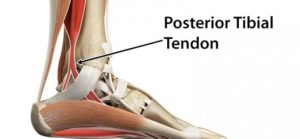Foot pain on the inside of the ankle running down into the arch, is commonly caused by posterior tibial tendon injury, one of the most important tendons in the foot.
The posterior tibial tendon provides stability and support to the arch on the inside of the foot when standing and walking, and is particularly active when running.
The posterior tibial tendon consists of collagen strands, similar to a nylon rope. Some of the individual strands of the tendon can become worn and knotted because of degeneration. Other fibers can tear and/or break, and the tendon loses its strength and ability to function.
Tendon injury occurs when the posterior tibial tendon becomes dysfunctional, inflamed, overstretched or torn. When this tendon is injured it is unable to provide stability and support for the arch of the foot, resulting in the most common cause of acquired flat foot.

Posterior tibial tendon injury can be acute in nature, when the force going through the tendon goes beyond what it can withstand, for example a tear or sprain during physical activity. However injury due to gradual wear and tear, associated with degeneration and overuse is more common.
Therefore posterior tibial tendon injury occurs more frequently in women and people over 40 years of age. Additional risk factors include obesity, diabetes, and poor training techniques.
Causes of Posterior Tibial Tendon Injury:
- Acute trauma due to a forceful contraction of the tibialis posterior muscle, often when in a position of stretch (i.e. rapid acceleration whilst running, particularly when changing direction).
- Overuse injury due to repetitive or prolonged activities placing strain on the posterior tibial tendon (i.e.running especially uphill, hiking, stair climbing).
- Poor foot biomechanics (flat feet) and/or inappropriate footwear.
- Recent increase in training or activity..
- Degeneration and weakening of the tendon (hormonal changes, age, medication).
Symptoms of Posterior Tibial Tendon Injury:
- Pain and/or swelling along the inside of the foot, arch and ankle bone, where the tendon runs and inserts.
- Pain on the outside of the ankle if the flat foot causes impingement of the ankle bones.
- Gradual onset which progressively worsens over time with continuation of aggravating weight bearing, especially under high intensity or impact.
- Trouble walking or standing for a long time, with aching and muscle fatigue.
- Difficulty with/unable to stand on one leg and rise up onto tiptoes on the injured side.
- Flat arch, if the tendon is torn or not functioning properly.
- Complete rupture will produce a pronounced flat foot.
- Thickened tendon due to scar tissue from wear and tear.
- Nodules or knots within the tendon, causing areas of weakness.
Treatment for Posterior Tibial Tendon Injury:
To enhance recovery, treatment should start as soon as possible. If left untreated, posterior tibial tendon injury may lead to irreversible damage, such as a inflexible flat foot and painful arthritis.
Non-Surgical
- R.I.C.E (rest, ice, compress, elevate) in acute injuries.
- Load program to strengthen the tendon, increase flexibility and balance.
- Shock Wave Therapy to reduce substance P causing pain in the tissue and initiate the healing and repair process.
- Prolotherapy to increase collagen production and strengthen the tendon.
- Dry needling to release knots in muscle and breakup nodules.
- Soft tissue massage and joint mobilisation.
- Cutomised foot orthotics and/or ankle bracing to correct the poor foot biomechanics and reduced load and stress placed on the tendon.
- Appropriate footwear to support the ankle and prevent rolling in of the foot, stretching the tendon.
- Moon boot, crutches or Richie brace in chronic conditions or post surgery.
Note: Cortisone injection is not recommended as it may increase risk of tendon rupture
Surgical
In chronic cases, that have not responded to conservative measures after 3 months or more, may require surgery.
Surgery can involve simple repair, debridement and realignment of the tendon and surrounding sheath. The majority of posterior tibial tendon surgery are complex and not ideal, as limitations to movement or activity may result.
The surgical outcome will depend on the flat foot severity and motion available in the foot before surgery. The more severe the tendon injury and condition, the poorer the prognosis will be. In many patients, it may be months before there is any significant improvement in pain.
Tendon injury can be diagnosed, treated and rehabilitated by our experienced staff at Well Heeled Podiatry to get you back to playing the sports or activities you love.









